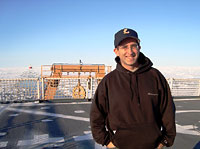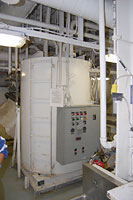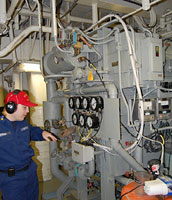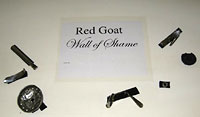

 | |||||||||||||||||||
|
|
Journals 2009/2010Jonathan Pazol
September 3, 2009 I have spent a lot of time the past few days coordinating "Live from the Arctic" phone calls with my students at West Leyden High School and other students as well. I received some grant money from the Leyden Credit Union, the Leyden High Schools District 212, and the Leyden Science department to rent a satellite phone (Thanks to all!). Before I came on the trip, I thought I might be able to Skype to my students, but those satellites do not orbit around the polar areas, so I made arrangements for the phone. And, we had nice weather again (if you can call 22° F nice - it was sunny, at least), so I wanted to show some Leyden spirit and let everyone know I'm thinking about them.
In previous Journal entries, I have written about how the food is served, what our cabins are like, how the engines run, how the ship is driven, and what we do for fun. But, I have not answered that most important question (and believe me, it's been asked many times), "What happens when you flush the toilets?" For obvious reasons, this and other logistical questions about things like drinking water, showers, trash, etc. are different on a ship than at home. I promise I will not get too graphic - I know my students will have a hard time believing that, as they know I really like all the gross, disgusting stuff in class. So this entry is safe for all readers. Without a lecture on digestion, once human "waste" is produced, it goes into a standard toilet (no picture necessary). The difference between this toilet and one at home are that the toilets on the Healy are more like airplane toilets. They use far less water and operate on a vacuum system. They also require special marine toilet paper, so as not to clog up the system. Then the waste from all around the ship is carried through clearly labeled pipes (for easy repair) to a storage tank.
Water is another big issue on the Healy. The ship uses a variety of water types and systems - cooling, science experiments, drinking, etc. There are systems for producing potable (drinkable) water, non-potable fresh water, distilled water, salt water, steam, and even the ballast water used to keep the ship stable. Where does all this water come from? The ocean, of course. The ship uses a highly complex desalinization (salt-removing) system and then bromine treatment (instead of chlorine like in most land-based systems) for producing the drinking water. It uses other treatment methods for each of the other water types. Depending on how the water gets used also determines how it eventually gets stored and processed, once it goes down a drain.
As far as garbage, the Healy has developed a very well-run, award-winning system. There are separate bins throughout the ship for recyclables, office paper, cardboard, trash, and food waste. In times past, ships used to be allowed to dump their garbage into the ocean, as long as they were a certain distance from shore. Fortunately, this is no longer the case. The garbage is collected during twice weekly clean-ups and placed in a shipping container (train-car sized) on the deck. Food waste gets sent down to the galley and is put through something affectionately called the "Red Goat." Like the super-powered microwave, the Red Goat is a garbage disposal "on steroids." During our first safety briefing, we got special warnings about being careful with this machine.
|
||||||||||||||||||




